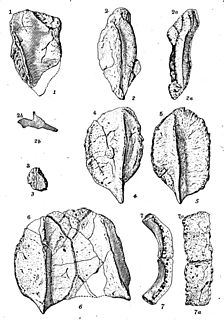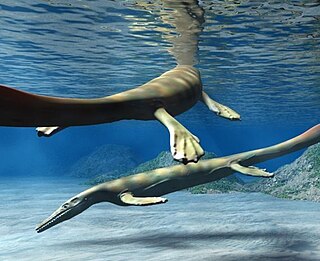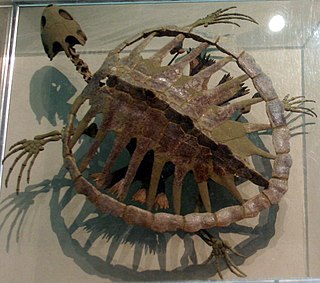
Hesperornithes is an extinct and highly specialized group of aquatic avialans closely related to the ancestors of modern birds. They inhabited both marine and freshwater habitats in the Northern Hemisphere, and include genera such as Hesperornis, Parahesperornis, Baptornis, Enaliornis, and Potamornis, all strong-swimming, predatory divers. Many of the species most specialized for swimming were completely flightless. The largest known hesperornithean, Canadaga arctica, may have reached a maximum adult length of over 1.5 metres (4.9 ft).

Ichthyornis is an extinct genus of toothed seabird-like ornithuran from the late Cretaceous period of North America. Its fossil remains are known from the chalks of Alberta, Alabama, Kansas, New Mexico, Saskatchewan, and Texas, in strata that were laid down in the Western Interior Seaway during the Turonian through Campanian ages, about 95–83.5 million years ago. Ichthyornis is a common component of the Niobrara Formation fauna, and numerous specimens have been found.

Hesperornis is a genus of cormorant-like bird that spanned the first half of the Campanian age of the Late Cretaceous period. One of the lesser-known discoveries of the paleontologist O. C. Marsh in the late 19th century Bone Wars, it was an early find in the history of avian paleontology. Locations for Hesperornis fossils include the Late Cretaceous marine limestones from Kansas and the marine shales from Canada. Nine species are recognised, eight of which have been recovered from rocks in North America and one from Russia.

The Smoky Hills are an upland region of hills in the central Great Plains of North America. They are located in the Midwestern United States, encompassing north-central Kansas and a small portion of south-central Nebraska.
Niobrarasaurus is an extinct genus of nodosaurid ankylosaur which lived during the Cretaceous 87 to 82 million years ago. Its fossils were found in the Smoky Hill Chalk Member of the Niobrara Formation, in western Kansas, which would have been near the middle of Western Interior Sea during the Late Cretaceous. It was a nodosaurid, an ankylosaur without a clubbed tail. It was closely related to Nodosaurus.

Hierosaurus is an extinct genus of nodosaurid ankylosaur which lived during the Late Cretaceous 87 to 82 million years ago. Its fossils were found in the Smoky Hill Chalk Member of the Niobrara Formation, in western Kansas, which would have been near the middle of the Western Interior Sea during the Late Cretaceous. It was a nodosaurid, an ankylosaur without a clubbed tail.

Eonatator is an extinct genus of marine lizard belonging to the mosasaur family. It is a close relative of Halisaurus, and part of the same subfamily, the Halisaurinae. It is known from the Late Cretaceous of North America, Colombia and Sweden. Originally, this taxon was included within Halisaurus, but was placed in its own genus, which also led to the subfamily Halisaurinae being created for the two genera.

Protosphyraena is a fossil genus of swordfish-like marine fish, that thrived worldwide during the Upper Cretaceous Period (Coniacian-Maastrichtian). Though fossil remains of this taxon have been found in both Europe and Asia, it is perhaps best known from the Smoky Hill Member of the Niobrara Chalk Formation of Kansas. Protosphyraena was a large fish, averaging 2–3 metres in length. Protosphyraena shared the Cretaceous oceans with aquatic reptiles, such as mosasaurs and plesiosaurs, as well as with many other species of extinct predatory fish. The name Protosphyraena is a combination of the Greek word protos ("early") plus Sphyraena, the genus name for barracuda, as paleontologists initially mistook Protosphyraena for an ancestral barracuda. Recent research shows that the genus Protosphyraena is not at all related to the true swordfish-family Xiphiidae, but belongs to the extinct family Pachycormidae.

Baptornis is a genus of flightless, aquatic birds from the Late Cretaceous, some 87-80 million years ago. The fossils of Baptornis advenus, the type species, were discovered in Kansas, which at its time was mostly covered by the Western Interior Seaway, a shallow shelf sea. It is now known to have also occurred in today's Sweden, where the Turgai Strait joined the ancient North Sea; possibly, it occurred in the entire Holarctic.
Polarornis is a genus of prehistoric bird, possibly an anserimorph. It contains a single species Polarornis gregorii, known from incomplete remains of one individual found on Seymour Island, Antarctica, in rocks which are dated to the Late Cretaceous.

Dolichorhynchops is an extinct genus of polycotylid plesiosaur from the Late Cretaceous of North America, containing three species, D. osborni, D. bonneri and D. tropicensis, as well as a questionably referred fourth species, D. herschelensis. Dolichorhynchops was an oceangoing prehistoric reptile. Its Greek generic name means "long-nosed face".

Apatornis is a genus of prehistoric birds endemic to North America during the late Cretaceous. It currently contains a single species, Apatornis celer, which lived around the Santonian-Campanian boundary, dated to about 83.5 million years ago. The remains of this species were found in the Smoky Hill Chalk of the Niobrara Formation in Kansas, United States. It is known from a single fossil specimen: a synsacrum, the fused series of vertebrae over the hips.

Parahesperornis is a genus of prehistoric flightless birds from the Late Cretaceous. Its range in space and time may have been extensive, but its remains are rather few and far between, at least compared with its contemporary relatives in Hesperornis. Remains are known from central North America, namely the former shallows of the Western Interior Seaway in Kansas. Found only in the upper Niobrara Chalk, these are from around the Coniacian-Santonian boundary, 85-82 million years ago (mya).

Toxochelys is an extinct genus of marine turtle from the Late Cretaceous period. It is the most commonly found fossilized turtle species in the Smoky Hill Chalk, in western Kansas.

The Niobrara Formation, also called the Niobrara Chalk, is a geologic formation in North America that was deposited between 87 and 82 million years ago during the Coniacian, Santonian, and Campanian stages of the Late Cretaceous. It is composed of two structural units, the Smoky Hill Chalk Member overlying the Fort Hays Limestone Member. The chalk formed from the accumulation of coccoliths from microorganisms living in what was once the Western Interior Seaway, an inland sea that divided the continent of North America during much of the Cretaceous. It underlies much of the Great Plains of the US and Canada. Evidence of vertebrate life is common throughout the formation and includes specimens of plesiosaurs, mosasaurs, and pterosaurs as well as several primitive aquatic birds. The type locality for the Niobrara Chalk is the Niobrara River in Knox County in northeastern Nebraska. The formation gives its name to the Niobrara cycle of the Western Interior Seaway.

The Smoky Hill Chalk Member of the Niobrara Chalk formation is a Cretaceous conservation Lagerstätte, or fossil rich geological formation, known primarily for its exceptionally well-preserved marine reptiles. Named for the Smoky Hill River, the Smoky Hill Chalk Member is the uppermost of the two structural units of the Niobrara Chalk. It is underlain by the Fort Hays Limestone Member; and the Pierre Shale overlies the Smoky Hill Chalk. The Smoky Hill Chalk outcrops in parts of northwest Kansas, its most famous localities for fossils, and in southeastern Nebraska. Large well-known fossils excavated from the Smoky Hill Chalk include marine reptiles such as plesiosaurs, large bony fish such as Xiphactinus, mosasaurs, flying reptiles or pterosaurs, flightless marine birds such as Hesperornis, and turtles. Many of the most well-known specimens of the marine reptiles were collected by dinosaur hunter Charles H. Sternberg and his son George. The son collected a unique fossil of the giant bony fish Xiphactinus audax with the skeleton of another bony fish, Gillicus arcuatus inside the larger one. Another excellent skeleton of Xiphactinus audax was collected by Edward Drinker Cope during the late nineteenth century heyday of American paleontology and its Bone Wars.
Colorado is a geologic name applied to certain rocks of Cretaceous age in the North America, particularly in the western Great Plains. This name was originally applied to classify a group of specific marine formations of shale and chalk known for their importance in Eastern Colorado. The surface outcrop of this group produces distinctive landforms bordering the Great Plains and it is a significant feature of the subsurface of the Denver Basin and the Western Canadian Sedimentary Basin. These formations record important sequences of the Western Interior Seaway, and as the geology of this seaway was studied, this name came to be used in states beyond Colorado, but was later replaced in several of these states with more localized names.

During the time of the deposition of the Niobrara Chalk, much life inhabited the seas of the Western Interior Seaway. By this time in the Late Cretaceous many new lifeforms appeared such as mosasaurs, which were to be some of the last of the aquatic lifeforms to evolve before the end of the Mesozoic. Life of the Niobrara Chalk is comparable to that of the Dakota Formation, although the Dakota Formation, which was deposited during the Cenomanian, predates the chalk by about 10 million years.

Dawndraco is a controversial genus of pteranodontid pterosaur from the Late Cretaceous of North America. It is likely synonymous with the contemporary pteranodontid Pteranodon sternbergi.
Brodavis is a genus of freshwater hesperornithiform birds known from the Late Cretaceous of North America and Asia. It was first described and named by Larry D. Martin, Evgeny N. Kurochkin and Tim T. Tokaryk in 2012 and assigned to a new monogeneric family, Brodavidae. Four species were described and assigned to Brodavis.































